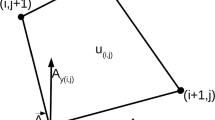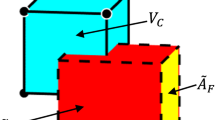Abstract
A newly developed method in the mixed space–wavenumber domain is proposed for 3D DC resistivity modeling in anisotropic structures. Unlike the traditional method for numerical simulation of DC resistivity, this method performs a 2D Fourier transform directly on the partial differential equation of DC abnormal potential along the horizontal direction, so that the horizontal direction is converted into the wavenumber domain while the vertical direction remains in the spatial domain. In this way, the 3D partial differential equation in the spatial domain is transformed into a 1D ordinary differential equation in different wave numbers. Therefore, a large-scale 3D numerical simulation problem is decomposed into many 1D numerical simulation problems. The 1D finite element method is used to solve the equations, and a contraction operator is used for iterative calculation to obtain a highly accurate solution. The accuracy of the algorithm is verified by comparison with the goal-oriented adaptive finite element method. Compared with the COMSOL Multiphysics commercial finite element simulation software, the algorithm in this paper has high computational efficiency. To identify the electrical anisotropy, we propose a new measurement and then use it to study the response characteristics of a half-space model with two prisms. The test results show that this measurement can accurately reflect the underground electrical anisotropy. Finally, the code is applied to the numerical simulation of a vertical-borehole survey and shows that the significant information on the hydraulically induced fracturing system can be reflected well by the electric anisotropy.











Similar content being viewed by others
References
Bibby, H. M. (1978). Direct current resistivity modeling for axially symmetric bodies using the finite element method. Geophysics, 43(3), 550–562.
Bibby, H. M. (1986). Analysis of multiple-source bipole–quadripole resistivity surveys using the apparent resistivity tensor. Geophysics, 51(4), 972–983.
Boisvert, R. F. (1991). Algorithms for special tridiagonal systems. Society for Industrial and Applied Mathematics, 12, 423–442.
Chen, G. B., Wang, H. N., & Yao, J. J. (2009). Modeling of electromagnetic responses of 3D electrical anomalous body in a layered anisotropic earth using integral equations. Chinese Journal of Geophysics, 52, 2174–2181 (in Chinese).
Coggon, J. H. (1971). Electromagnetic and electrical modelling by the finite element method. Geophysics, 36(1), 132–155.
Dey, A., & Morrison, H. F. (1979). Resistivity modeling for arbitrarily shaped three-dimensional structures. Geophysics, 44, 753–780.
Eloranta, E. H. (1988). The modelling of mise-à-masse anomalies in an anisotropic half-space by the integral equation method. Geoexploration, 25, 93–101.
Eskola, L. (1981). Addendum to “the solution of the stationary electric field strength and potential of a point current source in a 2 12-dimensional environment” by L. Eskola and H. Hongisto. Geophysical Prospecting, 32, 510–511.
Eskola, L. (1988). Reflections on the electrostatic characteristics of direct current in an anisotropic medium. Geoexploration, 25(3), 211–217.
Eskola, L. (1992). Geophysical interpretation using integral equations. Chapman & Hall.
Eskola, L., & Hongisto, H. (1997). Resistivity and IP modelling of an anisotropic body located in an isotropic environment. Geophysical Prospecting, 45(1), 127–139.
Flykt, M. J., Eloranta, E. H., & Nikoskinen, K. I. (1996). DC potential anomalies caused by a conducting body in an anisotropic conducting half-space. IEEE Transactions on Geoscience and Remote Sensing, 34(1), 27–32.
Gao, G. (2005). Simulation of borehole electromagnetic measurements in dipping and anisotropic rock formations and inversion of array induction data, Doctor’s Thesis. The University of Texas at Austin.
Hagrey, S. A. (1994). Electric study of fracture anisotropy at Falkenberg, Germany. Geophysics, 59(6), 881–888.
Hou, J., Mallan, R. K., & Verdin, C. T. (2006). Finite-difference simulation of borehole EM measurements in 3D anisotropic media using coupled scalar-vector potentials. Geophysics, 71(5), 225–233.
Li, P., & Uren, N. F. (1997). Analytical solution for direct current electric potential in an anisotropic half-space with a vertical contact, 67th Annual International Meeting of the Society of Exploration Geophysicists, Society of Exploration Geophysicists, Texas, pp. 410–414, Expanded abstracts.
Li, Y. G., & Spitzer, K. (2002). Three-dimensional dc resistivity forward modelling using finite elements in comparison with finite-difference solutions. Geophysical Journal International, 151, 924–934.
Li, Y. G., & Spitzer, K. (2005). Finite element resistivity modelling for three-dimensional structures with arbitrary anisotropy. Physics of the Earth and Planetary Interiors, 150, 15–27.
Lowry, T., Allen, M. B., & Shive, P. N. (1989). Singularity removal: A refinement of resistivity modelling techniques. Geophysics, 54(6), 766–774.
Penz, S., Chauris, H., & Donno, D. (2013). Resistivity modelling with topography. Geophysical of Journal International, 194(3), 1486–1497.
Pridmore, D. F., Hohmann, G. W., & Ward, S. H. (1981). An investigation of finite-element modelling for electrical and electromagnetic data in three dimensions. Geophysics, 46(7), 1009–1024.
Ren, Z. Y., Chen, H., & Tang, J. T. (2018a). A volume-surface integral approach for direct current resistivity problems with topography. Geophysics, 83, E293–E302.
Ren, Z. Y., Qiu, L., & Tang, J. (2018b). 3D direct current resistivity anisotropic modelling by goal-oriented adaptive finite element methods. Geophysical Journal International, 212, 76–87.
Spitzer, K. (1995). A 3-D finite-difference algorithm for DC resistivity modelling using conjugate gradient methods. Geophysical Journal International, 123, 903–914.
Tabarovskii, L. A. (1977a). Integral equation in anisotropic media. Soviet Geology and Geophysics, 18(1977), 65–71.
Tabarovskii, L. A. (1977b). Properties of the potential of a simple layer in an anisotropic medium. Soviet Geology and Geophysics, 18(1977), 67–73.
Wait, J. R. (1990). Current flow into a 3-dimensionally anisotropic conductor. Radioscience, 25, 689–694.
Wang, T., & Fang, S. (2001). 3-D electromagnetic anisotropy modelling using finite differences. Geophysics, 66(5), 1386–1398.
Wang, W., & Wu, X. P. (2010). Rapid finite element resistivity forward modeling for 3D arbitrary anisotropic structures. Progress in Geophysics, 25, 1365–1371 (in Chinese).
Wang, W., Wu, X. P., & Spitzer, K. (2011). 3D DC anisotropic resistivity modeling using unstructured finite element method: International Workshop on Gravity, Electrical and Magnetic Methods and Their Applications, Beijing, October 10–13.
Wang, W., Wu, X. P., & Spitzer, K. (2013). Three-dimensional DC anisotropic resistivity modelling using finite elements on unstructured grids. Geophysical Journal International, 193, 734–746.
Wu, L. (2014). High-precision Fourier forward modeling of potential fields: Gauss-FFT method, the Ph.D. thesis of Zhejiang University.
Wu, L., & Tian, G. (2014). High-precision Fourier forward modeling of potential field. Geophysics, 79, G59–G68.
Xu, S. Z. (1988). The finite element method for solving the direct-current electric field of point source on a 2-D anisotropic electric section. Journal of Shangdong College of Oceanology (in Chinese), 18, 18–90 (in Chinese).
Xu, S. Z. (1994). The finite element method in Geophysics. Science Press (in Chinese).
Yan, B., Li, Y., & Liu, Y. (2016). Adaptive finite element modeling of direct current resistivity in 2-D generally anisotropic structures. Geophysical Prospecting for Petroleum, 130, 169–176.
Yang, Z. L., Yin, C. C., & Ren, X. Y. (2018). Research on DC resistivity for an arbitrarily anisotropic earth using circular scanning measurement. ASEG Extended Abstracts, 1, 1–7.
Yin, C. C. (2000). Geoelectrical inversion for a one-dimensional anisotropic model and inherent non-uniqueness. Geophysical Journal International, 140, 11–23.
Zhao, S., & Yedlin, M. J. (1996). Some refinements on the finite-difference method for 3-D DC resistivity modelling. Geophysics, 61(5), 1301–1307.
Zhdanov, M. S., & Fang, S. (1997). Quasi-linear approximation in 3-D electromagnetic modeling. Geophysics, 61(3), 646–665.
Zhou, B., & Greenhalgh, S. A. (2001). Finite element three-dimensional direct current resistivity modelling: Accuracy and efficiency considerations. Geophysical Journal International, 145, 679–688.
Zhou, B., Greenhalgh, M., & Greenhalgh, S. A. (2009). 2.5-D/3-D resistivity modelling in anisotropic media using Gaussian quadrature grids. Geophysical Journal International, 176, 63–80.
Funding
This study was funded by Subproject of National Key Research and Development Plan (No. 2018YF C060360201), Independent Exploration and Innovation Project for Postgraduates of Central South University (Nos. 2018zzts200, 2018zzts203).
Author information
Authors and Affiliations
Corresponding author
Ethics declarations
Conflict of interest
The authors have not disclosed any competing interests.
Additional information
Publisher's Note
Springer Nature remains neutral with regard to jurisdictional claims in published maps and institutional affiliations.
Appendices
Appendix 1: Electric Field in Homogeneous Anisotropic Half-Space
According to Li and Uren (1997), in homogeneous anisotropic media, the coordinates of the source are \({\mathbf{r}}_{0} = \left( {x_{0},y_{0},z_{0} } \right)\), and the expression of the coordinate of its mirror source \({\mathbf{r^{\prime}}}_{0} = \left( {x^{\prime}_{0},y^{\prime}_{0},z^{\prime}_{0} } \right)\) is
where
Then, the electric field at the transceiver distance r is
where \({\mathbf{B}} = {\mathbf{r}}_{0}^{T} \cdot {{\varvec{\uprho}}} \cdot {\mathbf{r}}_{0}\), \({\mathbf{B^{\prime}}} = {\mathbf{r^{\prime}}}_{0}^{T} \cdot {{\varvec{\uprho}}} \cdot {\mathbf{r^{\prime}}}_{0}\),\({{\varvec{\upsigma}}} = {{\varvec{\uprho}}}^{ - 1}\).
Appendix 2: The Matrix Coefficient of the Equation
where l is the unit length.
Rights and permissions
About this article
Cite this article
Ling, J., Dai, S., Zhou, Y. et al. Three-Dimensional DC Anisotropic Resistivity Modeling Using a Method in the Mixed Space–Wavenumber Domain. Pure Appl. Geophys. 179, 2183–2200 (2022). https://doi.org/10.1007/s00024-022-03043-7
Received:
Revised:
Accepted:
Published:
Issue Date:
DOI: https://doi.org/10.1007/s00024-022-03043-7




